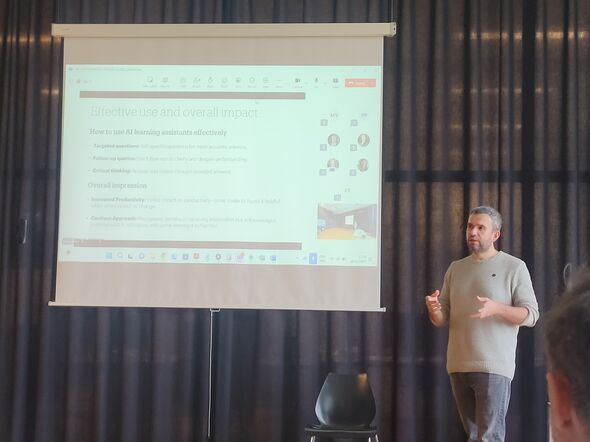How do we teach students to use ChatGPT?
Early November, TU/e teachers and other interested parties came together to discuss an urgent question: how are students using AI tools such as ChatGPT in their studies, and what does this mean for education? An interactive session, organized by the Academy for Learning & Teaching (ALT), covered opportunities and challenges, but concrete solutions are not yet within reach.
ALT was founded two years ago, to support teachers in their professional development. With the ‘lunch roundtables’ it organizes regularly, ALT creates a platform where teachers share experiences and join forces to deal with the everyday challenges and dilemmas of education. Topics that ALT pays a lot of attention to include the emergence of Large Language Models, such as ChatGPT and Copilot, as well as integrating Challenge-Based Learning into education.
Focus on student perspective
This is the first ALT session on Large Language Models that focuses on the student perspective, says Mitko Veta, assistant professor at the Department of Biomedical Engineering. TU/e doesn’t have a policy on the use of ChatGPT by students yet but it is in the works, the participants are told. As policy often lags behind technological developments, however, teachers already have complex questions they need answered.
Should they prohibit, regulate, or even encourage the use of ChatGPT by students? Where’s the line between acceptable use and fraud? And how can teachers monitor it? This session provides an opportunity to share experiences and perspectives and think about these dilemmas together.
Experiment: ChatGPT in practice
“Students are already using it, so there’s no point in banning it. Allow them to use it under supervision,” Veta contributes, based on his own experiences. Two years ago, he gave his students explicit permission to use generative AI tools like ChatGPT. In exchange, they had to fill out a questionnaire on their experiences at the end of the course. The results of this experiment generate valuable insights, which Veta shares with the participants during the session.
Before he does so, however, Veta gives an overview of Large Language Models: how they’re trained, how they work exactly, and in what ways students can use them. Alongside familiar applications, like text editing, rewriting, and translating, he also mentions less obvious ones: simplifying complex concepts, generating practice questions for exams, and even programming. “ChatGPT can assist in building code architecture, solving technical problems, and navigating complicated code syntax.”
Critical judgment
While ChatGPT has undeniable advantages, its use by students also raises concerns. “Access to information and knowledge is becoming easier and faster with every generation, but the quality of the data is also decreasing,” says Veta. “ChatGPT is not as reliable as books.”
Another danger is that we become too dependent on these technologies. “To get the most out of these systems, students need to learn to use AI tools efficiently,” he says. The big question, according to him, is: How can we teach students to use ChatGPT effectively?
He says that one of the most important skills required for this is critical judgment. Students need to be able to properly assess the reliability of the information generated and the sources used. “Everything that ChatGPT generates must be scrutinized by a critical human eye,” he emphasizes.
Bit of support
In the final part of his presentation, Veta reflects on the results of the questionnaires that students completed on their experiences with ChatGPT. The students who had taken his course were asked to indicate afterwards how helpful they found ChatGPT, whether using it made them less productive or more productive, what their ups and downs were, and how exactly they had used the AI tool.
The effects of ChatGPT varied within this group of students: some found it a valuable tool, while others didn’t think it was all that useful. Many students mentioned the disadvantage of increased dependency and passive learning attitude. But there were also surprising advantages. For example, students indicated that ChatGPT can help them move forward when they get stuck. The input from the tool can provide the little bit of support you need when you’re feeling down or demotivated.
Part and parcel
At the end, there’s room for discussion. Veta invites the teachers present to share their own experiences. “My students are allowed to use ChatGPT on the condition that they clearly state how and for what purpose they used it,” says a lecturer from Mechanical Engineering. According to him, whether or not you should allow its use depends on the learning objectives. “If the learning objective is to learn to write reports, then it makes no sense if students do the assessments using AI. I cannot assess what they have learned, so it’s a waste of time.” A lecturer from Built Environment estimates that about half of her students use ChatGPT to put together presentations and write reports. “I can usually recognize it, and then they admit it.”
“You can ask ChatGPT to check your text structure and style, but also to (re)write entire sentences. Where’s the line between assistance and plagiarism?” asks another participant. “And once we’ve determined that line together, how are we going to monitor it?” There are tools that can check texts for the use of generative AI, but these always lag behind the latest developments. Controlling or completely banning it is therefore impossible, is the consensus. Instead of focusing on control, it seems much more effective to provide students with tools to use AI tools responsibly. “Perhaps there should be a specific course on the use of ChatGPT,” suggests one of the attendees.
Although a definitive solution isn’t within reach just yet, this session was a step towards more awareness and collaboration. One thing is certain: ChatGPT and similar technologies have become part and parcel of education. Instead of holding back developments, teachers and students will have to learn how to use these tools optimally together – without losing sight of the human dimension and the learning objectives.



Discussion